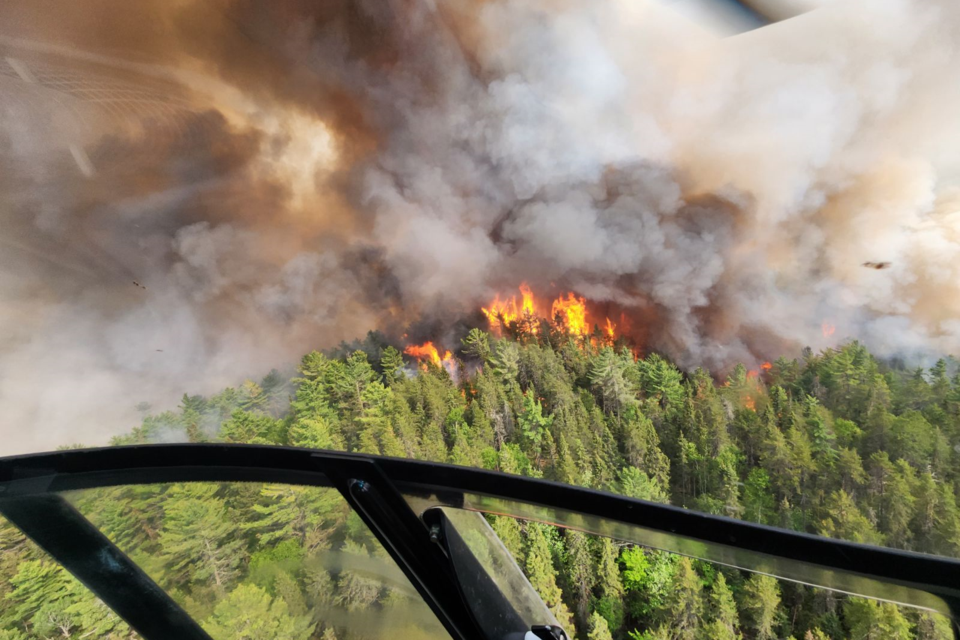Northern Ontario will get its turn. Wildfires are becoming a more regular occurrence as increasingly hot, dry weather turns forests into tinder. Wildfire smoke could travel and impact areas that are located thousands of kilometres away.
We experienced wildfire smoke this summer from the west. Scientists have determined the effects of smoke can cause serious health problems. Inhaling wildfire smoke can cause airway inflammation and lead to lung conditions like asthma and chronic obstructive pulmonary disease (COPD). There’s also a connection between wildfire smoke and cardiovascular disease.
Trees are our largest plants, what about them? Are they suffering as well?
Ontario science
Sarah Fig from Ministry of Natural Resources and Forestry (MNRF) media desk, canvassed government scientists when asked the question(s).
Here is some background knowledge we should keep in mind when considering the effects of wildfire smoke on trees and plants.
Forests influence the global carbon cycle by taking in atmospheric carbon dioxide (CO2) during photosynthesis and storing it in living and dead biomass. Healthy, faster-growing forests capture more atmospheric CO2, helping to mitigate climate change. Annual tree and forest growth is determined by temperature, precipitation, and growing season length. Natural disturbances such as fire, drought, and insect outbreaks can reduce CO2 uptake and forest growth.
She said, “Given the recent increase in frequency and duration of wildfire, and the projected further increase in fire activity under a warming climate, the global and regional effects of fire on Carbon storage and production of wood products have received a great deal of attention over the past few decades.
For this year Ms. Fig said, “Because exposure of some of Ontario’s forest to wildfire smoke was relatively brief, it is unlikely that annual growth was significantly reduced.
But she said, “It is unclear if observations of adverse effects on flower, fruit, and foliage production; tree health; and the timing of fall colour change are associated with smoke events, above average temperatures, or early drought during the 2023 growing season.
Smoke lab scientist
I wondered if there are wildfire smoke labs. An expert was located who has been studying this phenomenon for many years. Dr. Max Moritz is a Wildfire Specialist with the University of California - Agriculture and Natural Resources Division. His research is focused on understanding the dynamics of fire regimes at relatively broad scales and applying this information to planning, management, and policy relevant to fire-prone landscapes.
In a collaborative study, ‘Wildfires, complexity, and highly optimized tolerance,’ it was determined forest fires release a complex mixture of several different gases and aerosols into the atmosphere. Of these compounds, fine particulate matter and ozone have the most potential to influence forest growth.
Dr. Mortiz said, “The effects of short-term exposure to wildfire smoke on forests, agricultural crops, and other plant ecosystems is not well understood but trees seem to vary with length of exposure, tree species, climate, and proximity to active fire.
“Distance from the fire determines the density or thickness of the smoke, so how much particulate matter and ozone trees are exposed to, and air temperature and humidity during exposure.
“Forests closer to a fire are more likely to show effects from the combination of higher emission concentrations, higher air temperature, and lower humidity that can reduce photosynthesis.
He said, “Relatively brief exposure to wildfire smoke does not appear to have long-lasting effects on growth, with resumption of “normal” physiological activity occurring quickly after these events.”
What happens is this. Particulate matter increases the relative amount of diffuse sunlight that reaches trees. More diffuse sunlight generally increases photosynthesis by improving light conditions of shaded leaves in the lower tree canopy. “Heavy smoke, however, can reduce light in the canopy to levels that limit photosynthesis and reduce growth potential.
“Concentrations of atmospheric ozone, a powerful oxidant that is taken up by plants and reduces photosynthesis and growth, are also comparatively high during fire events. It is unclear whether the negative effects of ozone will outweigh the potential positive effects of particulate matter on the growth of trees near wildfires.
“Smoke from forest fires can persist in the environment for weeks and while there is a substantial amount of literature examining the effects of smoke exposure on seed germination, the effects of smoke on leaf function are nearly uninvestigated.”
In his smoke lab, “In general, smoke tended to have short-term effects on photosynthesis -- more/less shutting down in some instances less so in others -- but little is known about longer-term exposures.”
In summary, he said, “Because there are many compounds in smoke and we know so little about how they can affect plants, we have much to learn about the influence of smoke on plant function. The fact that different plant species can show varying responses to smoke, in addition to the potential for different plant species to produce their own complex suite of compounds, suggests there may be some intriguing roles for smoke in plant and ecosystem function.”
“In general, deciduous angiosperm species showed a greater sensitivity than evergreen conifers.”
For the gardeners and farmers the Ministry of Agriculture, Food and Rural Affairs was contacted. Erika DeBrouwer, Tree Fruit Specialist, referenced this excellent overview article entitled: ‘It’s Up in the Air: Concern about the Impacts of Smoke from Wildfire on Horticultural Crops - Wildfire effect on horticultural crops.’



